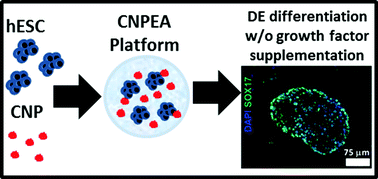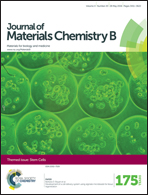Alginate encapsulation of chitosan nanoparticles: a viable alternative to soluble chemical signaling in definitive endoderm induction of human embryonic stem cells†
Abstract
Human embryonic stem cells (hESCs) are characterized by both their pluripotency and ability to self-renew, rendering them attractive for treatment of degenerative diseases. The cues necessary to induce hESC differentiation to a desired lineage can be categorized as either chemical or biophysical in nature. While chemical cues are used as primary inducers of differentiation, biophysical cues have been found to augment the process. In this regard, we have designed a novel chitosan nanoparticle augmented encapsulated alginate (CNPEA) platform which can not only augment, but induce differentiation of hESCs into the definitive endoderm (DE) lineage in the absence of specific soluble chemical inducers. These endoderm cells were comparable in phenotype with chemically driven DE cells and remained amenable to further maturation into pancreatic lineages. This study demonstrates the feasibility of carefully designed and tailored nanomaterials inducing differentiation, and moreover demonstrating the possibility of replacing growth factors by material cues.

- This article is part of the themed collection: Stem Cells

 Please wait while we load your content...
Please wait while we load your content...